If you want to recover files that are deleted either on purpose or by accident, get damaged by virus or even the partition is formatted, you can use this function to recover data. Actually, when the operating system deletes a file, it just marks the file "deleted" and make the disk space taken by the file as "free". Data isn't cleared and still stays on the disk. It is possible to rescue these deleted files by certain techniques as long as no files are created or new data is written in after the deletion.
The operation formatting neither considers the content of original data nor deletes old files first. The specific formatting operation varies with the file system type. For FAT32, FAT16, FAT12 and such kind of file system types, the formatting will clear the file allocation table (FAT in short, it is fixed in the beginning part of a partition and contains data's allocation information) and root directory. Usually data isn't be deleted. For NTFS file system, when formatted, new data written in doesn't have fixed position, but normally the writing position of every formatting doesn't change. Thus most of old files won't be overwritten and a large quantity of remained information can help us recover lost files.
This function is used to find out files and their hierarchical structure by analyzing some information left on the disk, so that files can be recovered.
If the whole partition is lost, please refer to the function "Search Lost Partitions (Partition Recovery)"at first and find out the lost partition. Then you can recover files from partition no matter the partition table is saved or not.
Partition is damaged if these happen: when you open a partition in My Computer, it prompts to "unformatted" or "it needs formatting"; its property shows "RAW"; no files of the partition are visible. This function can be used in these situations to recover data.
This function supports partition of NTFS, FAT32, FAT16, FAT12 and so on. Also it supports RAID volume, USB flash disk and memory card (such as SD card and XD card of cameras) which use these file system types.
To prevent the partition that is recovering data from secondary damage, when searching for files, DiskGenius adopts read-only mode so that no data can be written to the partition.
To recover files, first select the partition where deleted files have been saved; then click the button "File Recovery" on the tool bar, or click "Tools" on the main menu and select "Recover Lost Files", DiskGenius will pop up the following dialog box:

Because the data recovery process of formatted files and deleted files is different, we'll explain these two processes separately. The following is the detailed operating steps:
I recover deleted files:
Select "Recover deleted files" on the dialog box "Recover files".
If new data is written into the partition after the deletion, you'd better check the option "Search for Known File Types" and click the button "Select File types" to set files type to be recovered. After checking this option, DiskGenius will scan the whole free space. If it spots the demanded file type, it'll display these files in a folder "all types". If the deleted file can't be found in normal directory, it might be found in "all types" by its file name extension.
In many cases, files can not be recovered by common undelete function even if they are deleted just for a while, because files' important information has been destroyed by operating system or users' improper operations. And these secondary destructions caused by improper operations usually happen inadvertently, for example, when you delete a picture by accident, you may open the Windows Explorer right away to look for the deleted file in every directory and you use Windows' thumbnail preview function. These are the very operations that destroy much important information of the deleted file. The thumbnail preview generates cache files. Similar unintentional operations are too many. In this situation, you must adopt the method "scan file type" to recover data. Although files found by this method are named by number, you still can confirm them by previewing or opening then after they are copied out, which is especially effective to pictures and Office documents.
Since it'll take a little bit longer time to "scan fie type" (it scans the whole free space), it is suggested that the ordinary method be taken first. If you cannot find files you want to recover, then you can choose this mode.
If the file system type of the partition being searched is FAT32, you can also check the option "Recover earlier deleted files". Because of the feature that FAT 32file system deletes files, some deleted files can not be found if you don't scan the partition wholly. Recovering earlier deleted files takes more time, so it is advised that you scan the partition fist before using this solution.

Click "Start" to start scanning:

When the scanning is done, the "Recover files" dialog box will close by itself. DiskGenius displays files it finds out on the main interface. Every deleted file has a check box on its left side and the same with the items of the file folder tree, as follows:

As to those files and folders that can not be identified where they belongs, DiskGenius puts them together in a folder called "Lost Files". If you can not find deleted files on their original position, you can try to find them in this folder. Please do not forget this folder when you recover data and it is very possible that your important data is in this folder.
In the process of recovering files, the "Attribute" of deleted files in the file list will be added two more marks "D" and "X". D represents the file is a deleted file and X means that the file has been overwritten partly or wholly and it can not be totally recovered.
To facilitate users identify files searched out, DiskGenius can display normal files at the same time, the way is selecting menu items "View"->"Show normal files". Normal files have no check boxes and they can not be selected.
To recover files, please choose files on the check box; then right click the mouse button or click "File"->"Copy to". Choose a file folder to save recovered files and click "OK". DiskGenius will copy files you selected to the appointed folder. To prevent data of the partition recovering data from secondary destruction, files are not allowed to be copied to original partition.
Click "Complete" button and close Copy File dialog box and DiskGenius will automatically clear files' chosen state to select other files.
When all data are copied out, you can click "Partition" and "Reload Current Partition" in turn to release cache data of the current partition from memory and load current partition from disk to show the state of current partition.
II Whole partition file recovery (recover formatted files)
Select "Whole partition file recovery" on the dialog box "Recover files". Meanwhile it is advised that the option "Search for Known File Types" be checked and the button "Select File Types" be clicked to set file types that need recovering. Check this option, DiskGenius will scan partition as well as recover files by type according to file header of appointed file types. When it finishes recovery, DiskGenius will divide directory by file extension and arrange all files found out to a virtual partition. This method is a little bit slow but it doesn't affect normal recovery and it can recover more files.
Click "Start" to start scanning process. This searching method takes more time. And the following operating steps are the same as "Recover deleted files". Please refer to the method mentioned in former part to select and copy files. |






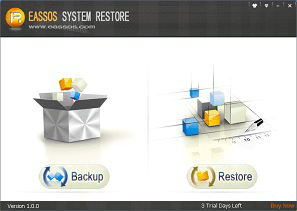
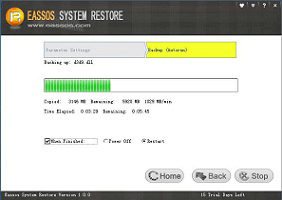
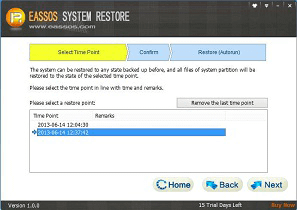
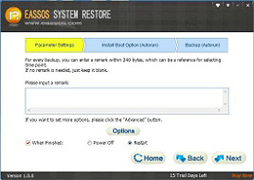
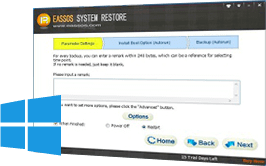

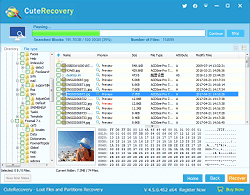
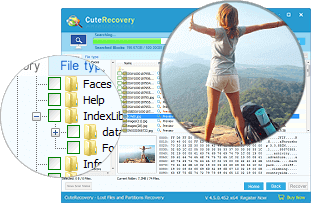
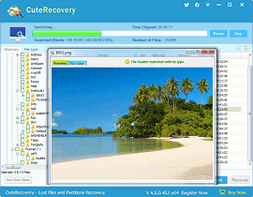


















 Facebook
Facebook X
X Youtube
Youtube